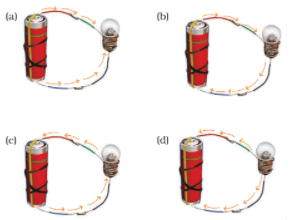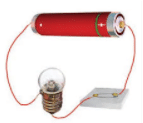NCERT Exemplar Solutions: Electricity and Circuits | Science for Class 6 PDF Download
Multiple Choice Questions
Q1: Choose from the options a, b, c and d given in the fig 12.1 which shows the correct direction of current.
 View Answer
View Answer 
Ans: (b)
In an electric circuit, the direction of current flows from the positive terminal to the negative terminal of the electric cell.
Q2: Choose the incorrect statement.
(a) A switch is the source of electric current in a circuit.
(b) A switch helps to complete or break the circuit.
(c) A switch helps us to use electricity as per our requirement.
(d) When the switch is open there is an air gap between its terminals.
 View Answer
View Answer 
Ans: (a)
An electric cell is the source of electric current in a circuit not the switch.
Q3: In an electric bulb, light is produced due to the glowing of
(a) the glass case of the bulb
(b) the thin filament
(c) the thick wires supporting the filament
(d) gases inside glass case of the bulb.
 View Answer
View Answer 
Ans: (b)
Q4: In the following arrangement shown in fig 12.2, the bulb will not glow if the ends A and B are connected with (a) A steel spoon
(a) A steel spoon
(b) A metal clip
(c) A plastic clip
(d) A copper wire
 View Answer
View Answer 
Ans: (c)
Plastic clip is a poor conductor of electricity, it is an insulator.
Q5: In the circuit shown in fig 12.3, when the switch is moved to ‘ON’ position, (a) the bulb A will glow first
(a) the bulb A will glow first
(b) the bulb B will glow first
(c) the bulb C will glow first
(d) all bulbs will glow together
 View Answer
View Answer 
Ans: (d)
As soon as the circuit gets completed, current is found at every point in the circuit instantly.
Q6: Filament of a torch bulb is
(a) a metal case
(b) metal tip at the centre of the base
(c) two thick wires
(d) a thin wire
 View Answer
View Answer 
Ans: (d)
Q7: Paheli is running short of connecting wires. To complete an electric circuit, she may use a
(a) glass bangle
(b) thick thread
(c) rubber pipe
(d) steel spoon
 View Answer
View Answer 
Ans: (d)
Steel spoon is a good conductor of electricity. Hence, we use steel spoon to complete an electric circuit.
Q8: In which of the following circuits A, B and C given in fig 12.4, the cell will be used up very rapidly?
 View Answer
View Answer 
In circuit A, the cell will be used up very rapidly.
Q9: Fig. 12.5 shows a bulb with its different parts marked as 1,2,3,4 and 5. Which of them label the terminals of the bulb?
 View Answer
View Answer 
Labels 3 and 4 are the terminals of the bulb.
Short Answer Questions
Q10: You are provided with a bulb, a cell, a switch and some connecting wires. Draw a diagram to show the connections between them to make the bulb glow.
Q11: Will the bulb glow in the circuit shown in fig 12.6 ? Explain.
 View Answer
View Answer 
No, the bulb will not glow in this circuit because the switch is open and the circuit is broken. Current flows only in a closed circuit.
Q12: An electric bulb is connected to a cell through a switch as shown in fig 12.7. When the switch is brought in ‘ON’ position, the bulb does not glow. What could be the possible reason/s for it? Mention any two of them.
 View Answer
View Answer 
(i) Loose connections.
(ii) Connecting wires are broken.
(iii) The cell is a used one.
(iv) The bulb is fused.
Q13: A torch requires 3 cells. Show the arrangement of the cells, with a diagram, inside the torch so that the bulb glows.
Q14: When the chemicals in the electric cell are used up, the electric cell stops producing electricity. The electric cell is then replaced with a new one. In case of rechargeable batteries (such – as the type used in mobile phones, camera and inverters), they are used again and again. How?
 View Answer
View Answer 
Rechargeable batteries can be recharged by providing them appropriate current through secondary cells or storage cells.
Q15: Paheli connected two bulbs to a cell as shown in fig 12.8, She found that filament of bulb B is broken. Will the bulb A glow in this circuit? Give reason.
She found that filament of bulb B is broken. Will the bulb A glow in this circuit? Give reason.
 View Answer
View Answer 
No, the bulb will not glow in this circuit as the filament of bulb B is broken. Due to the breakage in the circuit current does not flow.
Q16: Why do bulbs have two terminals?
 View Answer
View Answer 
A bulb has a tiny thin wire called filament which consists of two terminals to connect the filament within the circuit so that current can pass through it.
Q17: Which of the following arrangement A, B, C and D given in fig 12.9 should not be set up? Explain, why?
 View Answer
View Answer 
Arrangement A should not be set up since the current flows from a negative terminal to the positive terminal which will exhaust the cell very quickly as the large current will flow through it.
Q18: A fused bulb does not glow. Why?
 View Answer
View Answer 
A fused bulb does not glow since the filament inside it is broken and the circuit is incomplete.
Q19: Paheli wanted to glow a torch bulb using a cell. She could not get connecting wires, instead, she got two strips of aluminium foil. Will she succeed? Explain, how?
 View Answer
View Answer 
Yes, Paheli will succeed. Aluminium foil being a good conductor of electricity it can be used as connecting wires for the supply of electricity.
Long Answer Questions
Q20: Boojho has a cell and a single piece of connecting wire. Without cutting the wire in two, will he be able to make the bulb glow? Explain with the help of a circuit diagram.
 View Answer
View Answer 
Yes, he can succeed in getting the bulb glow by using the given arrangements.
He can connect by connecting to a positive terminal of the cell directly from the second terminal of the bulb as given in the figure. In this way, the circuit will get completed without using another piece of connecting wire.
Q21: Fig 12.10 A and B, show a bulb connected to a cell in two different ways. (i) What will be the direction of the current through the bulb in both the cases (Q to P or P to Q)?
(i) What will be the direction of the current through the bulb in both the cases (Q to P or P to Q)?
(ii) Will the bulb glow in both the cases?
(iii) Does the brightness of the glowing bulb depend on the direction of current through it?
 View Answer
View Answer 
(i) In the case of Q to P: the current flows from the positive terminal to the negative terminal. In case of P to Q: the current flows from the negative terminal to the positive terminal.
(ii) Yes, the bulb will glow in both the cases as the current is flowing and the circuit is complete.
(iii) No, the brightness of the glowing bulb does not depend on the direction of current through it. Amount of current and voltage in the circuit decides the brightness of the glowing blub.
Q22: Think of six activities which use electric current. Also name the devices used to perform the activity.
Q23: A torch is not functioning, though contact points in the torch are in working condition. What can be the possible reasons for this? Mention any three.
 View Answer
View Answer 
The possible reasons for the torch to not function could be
(i) The switch may be faulty.
(ii) The cells may not be placed in the correct order.
(iii) The cells may have been used up.
(iv) The filament may be fused in the bulb.
|
69 videos|288 docs|27 tests
|
FAQs on NCERT Exemplar Solutions: Electricity and Circuits - Science for Class 6
| 1. What is the difference between a series circuit and a parallel circuit? |  |
| 2. How does Ohm's Law relate to electricity and circuits? |  |
| 3. What are the main components of an electric circuit? |  |
| 4. Why is it important to use a fuse in an electrical circuit? |  |
| 5. What factors affect the resistance in a circuit? |  |




















